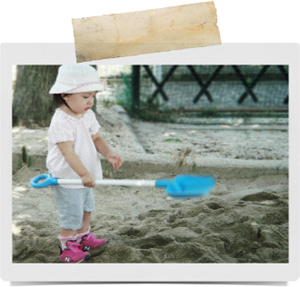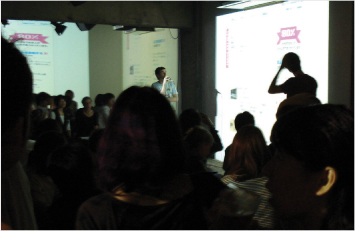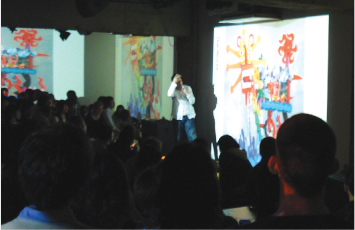Presentation Zen: Simple Ideas on Presentation Design and Delivery, 2nd Edition (Ira Katz's Library) (6 page)
Authors: Garr Reynolds

Children are naturally creative, playful, and experimental. If you ask me, we were the most human when we were young kids. We “worked” on our art, sometimes for hours without a break, because it was in us, although we didn’t intellectualize it. As we got older, fears crept in along with doubts, self-censoring, and overthinking. The creative spirit is in us now; it’s who we are. We just need to look at the kids around us to be reminded of that. Whether you are 28 or 88, it’s never too late, because the child is still in you.

“In the beginner’s mind there are many possibilities, in the expert’s mind there are few.”
—Shunryu Suzuki
Creative power and creative imagination are not only for the artists of the world—painters, sculptors, and so on. Teachers also need the power of creativity. So do programmers, engineers, scientists, etc. You can see the application of creative genius in many professional fields. Remember, it was a group of brilliant and geeky-to-the-core, left-brain NASA engineers on the ground who were able to jury-rig a solution to the life-threatening buildup of carbon dioxide in the damaged Apollo 13 spacecraft back in 1970. Their heroic fix—literally involving duct tape and spare parts—was ingenious improvisation; it was imaginative and creative.
Being creative does not mean wearing a black turtleneck and hanging out in jazz cafés sipping cappuccinos. It means using your whole mind to find solutions. Creativity means not being paralyzed by your methods and knowledge, but being able to think outside the box (sometimes very quickly) to find solutions to unforeseen problems. This kind of situation requires logic and analysis, but also big-picture thinking. And big-picture thinking is a right-brain, creative aptitude.
Back down here on earth, the seemingly mundane business of a conference presentation, designed and delivered with the help of slideware, can be a very creative thing. A presentation is an opportunity to differentiate yourself, your organization, or your cause. It’s your chance to tell the story of why your content is important and why it matters. It can be an opportunity to make a difference. So why look or talk like everyone else? Why strive to meet expectations? Why not surpass expectations and surprise people?
You are a creative person—probably far more creative than you think. All people should work toward tapping into their creative abilities and unleashing their imaginations.
If You Want to Write
by Brenda Ueland (Graywolf Press) is one of the most inspiring and useful books I have ever read. The book was first published in 1938 and probably should have been titled “If You Want to Be Creative.” Her simple yet sage advice will be of interest not only to writers but to anyone who yearns to be more creative in their work or to help others get in touch with their creative souls (this goes for programmers and epidemiologists, as well as designers and artists). This book should be required reading for all professionals and especially those aspiring to teach anyone about anything. Following are ideas inspired by Brenda Ueland that you should keep in mind when preparing for a presentation or any other creative endeavor in your work.
Ah, the big lie we tell ourselves: “I am not creative.” Sure, you might not be the next Picasso in your field. (Then again, who knows?) But it doesn’t matter. What matters is to not close yourself down too early in the exploration process. Failing is fine; it’s necessary, in fact. But avoiding experimentation or risk—especially out of fear of what others may think—is something that will gnaw at your gut more than any ephemeral failure. A failure is in the past. It’s done and over. But worrying about “what might be if...” or “what might have been if I had...” are pieces of baggage you carry around daily. They’re heavy, and they’ll kill your creative spirit. Take chances and stretch yourself. You’re only here on this planet once, and for a very short time at that. Why not just see how gifted you are? You may surprise someone. Most importantly, you may surprise yourself.

Image in this slide is of Sir Ken Robinson presenting at TED in 2006. (Original photo courtesy of TED/leslieimage.com.)
Inspiration. Where can you find it? You can find inspiration in a million places, in a million ways—but probably not in your same old routine. Sometimes, you can find inspiration in teaching. When you teach someone something important to you, you are reminded of why it matters, and the enthusiasm of the student—child or adult—is infectious and energizing. Ueland says, “I helped them by trying to make them feel freer, bolder. Let her go! Be careless, reckless! Be a lion. Be a pirate!” You know it’s important to be free, free like children are. You just need to be reminded of that occasionally.
Idling—doing nothing—is important. Most of us, myself included, are obsessed with getting things done. We’re afraid to be unproductive. And yet, the big ideas often come during your periods of “laziness,” during those episodes of “wasting time.” People need more time away from the direct challenges of work. Taking long walks on the beach, jogging through the forest, going for bike rides, reading the Sunday paper for four to five hours in a coffee shop. During these times, your creative spirit is energized. Sometimes you need solitude and a break to slow down so that you may see things differently. Managers who understand this and give their staff the time they need (which they can only do by genuinely trusting them) are the secure managers—and the best managers.
Put your love, passion, imagination, and spirit behind it. Without enthusiasm, there is no creativity. It may be a quiet enthusiasm, or it may be loud. It doesn’t matter, as long as it is real. I remember a guy’s comment on a successful long-term project of mine: “Well, you have enthusiasm, I’ll give you that.” He didn’t realize that it was a backhanded compliment. These are the people who get us down. Life is short. Don’t hang out with people who dismiss the idea of enthusiasm, or worse still, with those who try to kill yours. Trying to impress others or worrying about what others may think of your enthusiasm or passion should be the last thing on your mind.
When forced to work within a strict framework the imagination is taxed to its utmost—and will produce its richest ideas. Given total freedom the work is likely to sprawl.
—T.S. Eliot
My friends at Universal Studios Japan—Jasper von Meerheimb, senior art director, and Sachiko Kawamura, senior environmental graphic designer—gave an excellent presentation for Design Matters Japan on the issue of how restrictive conditions put on creative projects can lead to inventive solutions. In their presentation, they talked about how to develop concepts and implement them under constraints such as limited time, space, and budgets. For professional designers, creating great work under a thousand constraints and limitations imposed from the outside is simply the way the world of design works. Whether constraints are good or bad, enabling or crippling, is in a sense irrelevant; constraints are the way of the world. Still, as John Maeda points out in
The Laws of Simplicity
(MIT Press), “In the field of design there is the belief that with more constraints, better solutions are revealed.” Time, for example, and the sense of urgency that it brings, is almost always a constraint, yet “urgency and the creative spirit go hand in hand,” says Maeda.
Using creativity and skill to solve a problem or design a message among a plethora of restrictions from the client, the boss, and so on, is old hat to designers. They live it. Daily. However, for the millions of nondesigners with access to powerful design tools, the importance of constraints and limitations is not well understood. For those not trained in design, the task of creating presentation visuals (or posters, websites, newsletters, etc.) with today’s software tools can make users frustrated by the abundance of options or giddy in anticipation of applying their artistic sensibilities to decorate their work with an ever-increasing array of colors, shapes, and special effects. Either condition can lead to designs and messages that suffer. What you can learn from professional designers is that (1) constraints and limitations are a powerful ally, not an enemy, and (2) creating your own self-imposed constraints, limitations, and parameters is often fundamental to good, creative work.
Self-imposed constraints can help you formulate clearer messages, including visual messages. In the various Zen arts, for example, you’ll find that careful study, practice, and adherence to strict guidelines (constraints) serve to bring out the creative energy of the individual. For example, haiku has a long tradition and strict guidelines, yet with much practice one can create a message (in 17 syllables or less) that captures both the details and the essence of a moment. The form of haiku may have strict rules, but the rules are what can help you express your own “haiku moments” with both subtlety and depth. In
Wabi Sabi Simple
(Adams Media Corporation, 2004), author Richard Powell comments on wabi sabi, discipline, and simplicity as they relate to such arts as bonsai and haiku:



